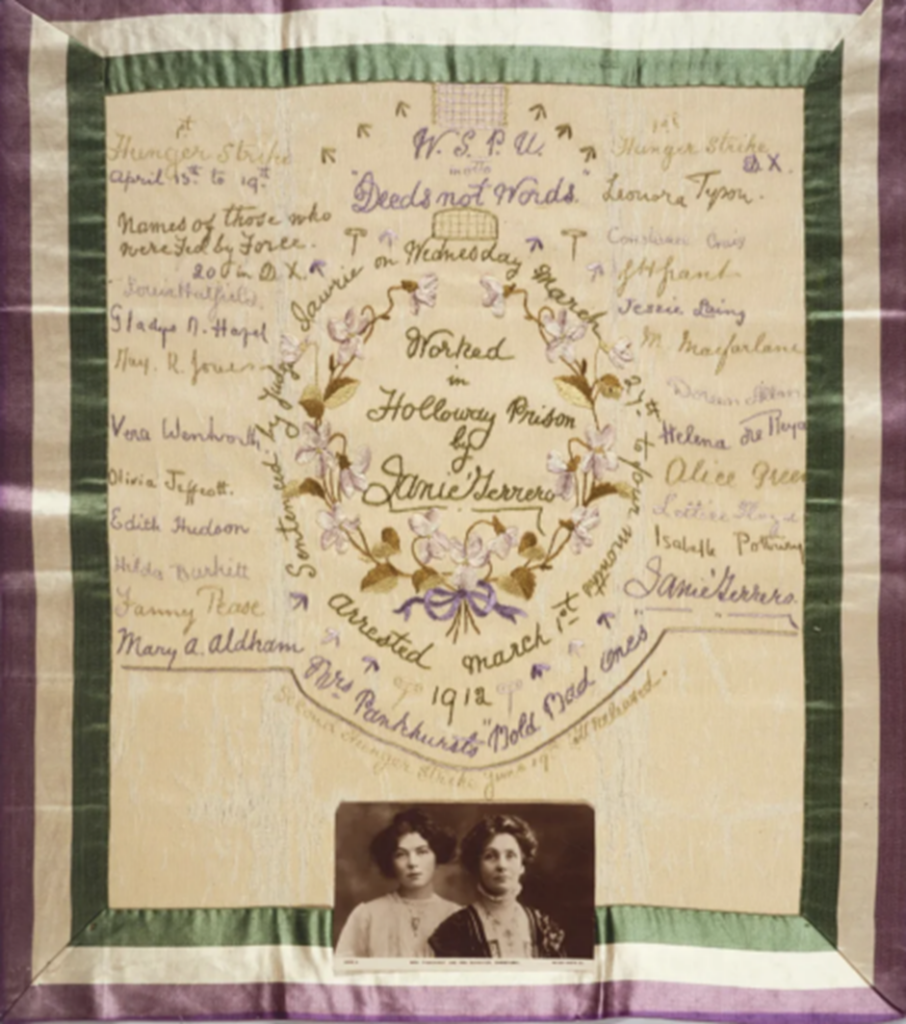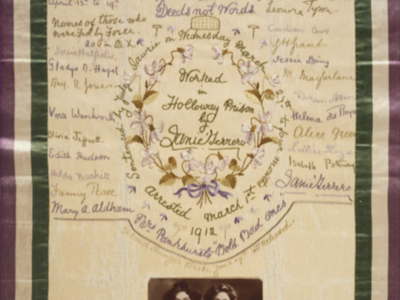The WSPU’s 1912 Window-Smashing Campaign
By Jack Stephenson
March of 1912 saw a fierce struggle for Women’s Suffrage engulf the streets of London, leaving a trail of shattered glass and a resounding call for change. The 1st of March saw the start of a Window Smashing Campaign that would see over 150 members of the Women’s Social and Political Union smash numerous windows in the Capital.
Their aim? To disrupt the societal norms and highlight the urgency of Women’s Suffrage.
While the Suffragettes had previously used window smashing as a form of disorderly protest, the Window Smashing Campaign of 1912 saw disruptive action being carried out on a scale not previously undertaken by the WSPU. The police were made aware of the planned disturbance and officers were ready to make a number of arrests, with officers from the special branch being stationed outside of the WSPU meeting place of the Gardenia Restaurant.[1] Despite their preparation, the police were overwhelmed, and the 150 strong window-smashing suffragettes succeeded in damaging the windows of a large number of properties. By the end of the campaign, 126 women would face trial for their roles played.
Of the 126 Women that faced trial 76 were given the sentence of hard labour.[2] While Holloway Prison was the first prison of choice by magistrates, not all WSPU members were sent there. Kitty Marion, a Suffragette who was arrested and charged for her role in the campaign, recalls in her autobiography that due to Holloway Prison being overcrowded, along with 23 other women she was transported to Winson Green Prison in Birmingham. Marion subsequently went on hunger strike and was released after 10 days.[3] Kitty Marion was also one of a number of Suffragettes that had previously been arrested for window smashing. In 1909 Marion had been arrested for smashing the window of a post office in Newcastle.[4]
It was reported due to Holloway Prison being jammed to the rafters, ‘many Suffragettes were locked up; routine discipline and control broke down. Exercise and work became mass singing sessions; women sewed suffrage banners and handkerchiefs.’[5] By turning their imprisonment into a platform for activism and camaraderie, the suffragettes were able to amplify their message and demonstrate commitment to the suffrage movement. The overcrowded conditions of the prison inadvertently created an environment where the suffragettes could organise and support one another, further highlighting their determination to fight for women’s suffrage.

Due to its proximity to a number of the sites targeted by the campaign, Bow Street Court and Cells were used to bring many of the women to trial and to house them following their arrests. Suffragette Victoria Lidiard recalls being arrested and brought back to Bow Street. “He just looked at me. Meanwhile another policeman rushed up towards me and then an inspector on horseback came. So I was escorted to Bow Street, a policeman on each side of me, clutching my arm. and one behind. Well, I had eight stones, but I’d only used one so on the way to the police station I dropped them one by one and to my amazement when I was taken down at Bow Street, this policeman that had followed put the seven stones on the table and said, ‘She dropped these on the way.”[6]

While the Window Smashing Campaign took place across much of London’s West End, The Strand saw significant activity with numerous sites being targeted.
Such sites were:
– Chemist Shop of Starkie at 126 Strand.[7]
– The Grand Hotel, Trafalgar Square.[8]
– The Savoy Hotel.
– Aerated Bread Company Tea-Shop.[9]
– Hotel Cecil.[10]
– Lowther Arcade.[11]
– Grand Trunk Railway Headquarters.[12]
– The Walk-Over shoe company on The Strand.[13]


The window smashing campaign stands as a reminder of the complex interplay between activism, social change and the boundaries of protest methods. With the campaign highlighting how quickly society reacted to damaged property as opposed to the actions taken to tackle women’s suffrage. Suffragette Lillian Ball wrote on her toffee hammer, ‘Better Broken Windows than Broken Promises’ showing the importance that the campaign had on calling out societies unwillingness to address the WSPU’s demands.
A New walking tour at Bow Street Police Museum
Bow Street Police Museum is happy to announce our new walking tour: Reform, Rebel, RIOT! Civil Disobedience in Covent Garden.
Bow Street has seen all sorts of protestors pass through its cells and courts, from xenophobic footmen of the 18th century descending on the magistrate’s house en masse, discontented theater-goers drowning out performances every night for weeks to window-smashing suffragettes demanding votes for women.
Jack’s research was invaluable to our team in setting up the suffragette part of the tour. So if you’re interested in hearing more, why not join us as we explore the causes of the disaffected, how law enforcement reacted and ask, crucially, did they make any difference?
Book tickets here.
Bibliography:
Godfrey, Jennifer. “Suffragettes of Kent.” United Kingdom: Pen & Sword Books, (2019.)
‘‘Today In London Smashing Herstory, 1912: Suffragettes Demolish West End Windows.’ https://pasttense.co.uk/2022/03/01/today-in-london-smashing-herstory-1912/comment-page-1/
‘London Street Views.’ https://londonstreetviews.wordpress.com/category/13-strand-division-5-nos-1-68-and-415-457/
‘London Street Views.’ accessed 19 July, https://londonstreetviews.wordpress.com/2013/05/02/edward-clarke/
Katie Fox Vicky Iglikowski-Broad, “Suffragettes, 1912: ‘Rather Broken Windows than Broken Promises,’” The National Archives blog, March 9, 2018, https://blog.nationalarchives.gov.uk/rather-broken-windows-broken-promises/.
Kitty Marion “Actor and Activist.” United Kingdom: Manchester University Press, (2019.)
“Kitty Marion ,” Spartacus Educational, accessed July 6, 2023, https://spartacus-educational.com/WmarionK.htm.
“May Billinghurst,” Spartacus Education https://spartacus-educational.com/Wbillinghurst.htm
“Victoria Lidiard,” Spartacus Educational, accessed July 6,2023 https://spartacus-educational.com/Wlidiard.htm.
Rosen Andrew, ‘Rise Up, Women!’, Routledge, (1974) https://www.johndclare.net/Women1_SuffragetteActions_Rosen.htm
McWilliam, Rohan. ‘London’s West End: Creating the Pleasure District, 1800-1914.’ United Kingdom: Oxford University Press,(2020.) P.313
Photographs and Documents:
Aerated Tea company Photograph: https://collections.museumoflondon.org.uk/online/object/731301.html
Illustrated London News: https://pasttense.co.uk/2022/03/01/today-in-london-smashing-herstory-1912/comment-page-1/
Meeting Pamphlet: https://blog.nationalarchives.gov.uk/rather-broken-windows-broken-promises/
Photograph of Suffragettes at Bow Street: https://blogs.lse.ac.uk/lsehistory/2023/03/07/remembering-the-suffragettes-bow-street-police-station/
Police Summons: https://artsandculture.google.com/asset/police-summons-issued-to-janie-terrero/mQFNNasf5G1dGQ
Square of Embroidery: https://www.smithsonianmag.com/smart-news/london-exhibit-reveals-stories-forgotten-suffragettes-180968050/
‘Toffee Hammer Used for Smashing Windows.’ Museum of London.https://artsandculture.google.com/asset/toffee-hammer-used-for-breaking-windows/-gFrsVDb33CKvg?hl=en
[1] Katie Fox Vicky Iglikowski-Broad, “Suffragettes, 1912: ‘Rather Broken Windows than Broken Promises,’” The National Archives blog, March 9, 2018, https://blog.nationalarchives.gov.uk/rather-broken-windows-broken-promises/.
[2] Katie Fox Vicky Iglikowski-Broad, “Suffragettes, 1912: ‘Rather Broken Windows than Broken Promises,’” The National Archives blog, March 9, 2018, https://blog.nationalarchives.gov.uk/rather-broken-windows-broken-promises/.
[3] Kitty Marion “Actor and Activist.” United Kingdom: Manchester University Press, (2019.)
[4] “Kitty Marion ,” Spartacus Educational, accessed July 6, 2023, https://spartacus-educational.com/WmarionK.htm.
[5] Today In London Smashing Herstory, 1912: Suffragettes Demolish West End Windows’
[6] Victoria Lidiard,” Spartacus Educational, accessed July 6,2023 https://spartacus-educational.com/Wlidiard.htm.
[7] London Street Views.’ https://londonstreetviews.wordpress.com/category/13-strand-division-5-nos-1-68-and-415-457/
[8] London Street Views.’ https://londonstreetviews.wordpress.com/category/13-strand-division-5-nos-1-68-and-415-457/
[9] Broken Windows at Aerated Bread Company’ https://collections.museumoflondon.org.uk/online/object/731301.html
[10] Katie Fox Vicky Iglikowski-Broad, “Suffragettes, 1912: ‘Rather Broken Windows than Broken Promises,’” The National Archives blog, March 9, 2018, https://blog.nationalarchives.gov.uk/rather-broken-windows-broken-promises/.
[11] London Street Views.’ accessed 19 July, https://londonstreetviews.wordpress.com/2013/05/02/edward-clarke/
[12] Rosen Andrew, ‘Rise Up, Women!’, Routledge, (1974) https://www.johndclare.net/Women1_SuffragetteActions_Rosen.htm
[13] McWilliam, Rohan. ‘London’s West End: Creating the Pleasure District, 1800-1914.’ United Kingdom: Oxford University Press, (2020.) P.313

